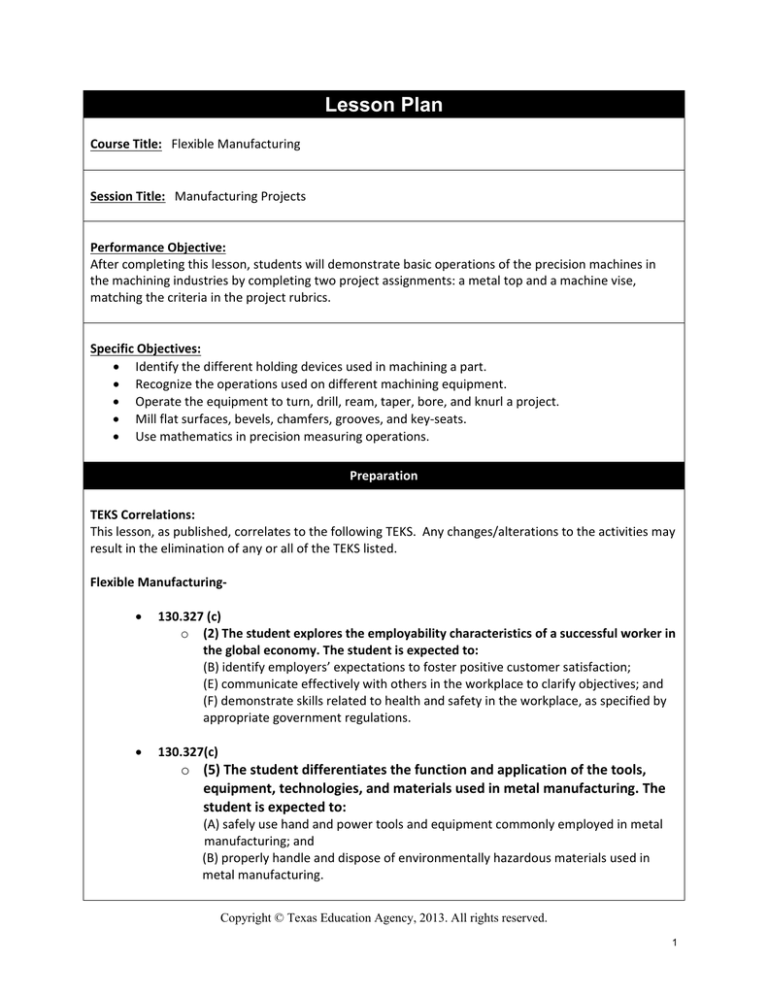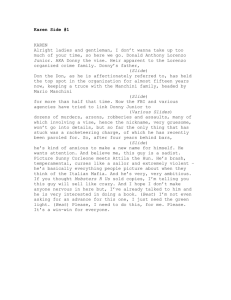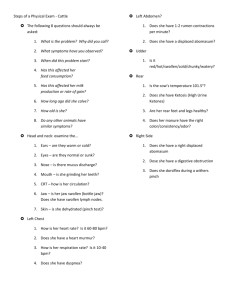Lesson Plan
advertisement

Lesson Plan Course Title: Flexible Manufacturing Session Title: Manufacturing Projects Performance Objective: After completing this lesson, students will demonstrate basic operations of the precision machines in the machining industries by completing two project assignments: a metal top and a machine vise, matching the criteria in the project rubrics. Specific Objectives: Identify the different holding devices used in machining a part. Recognize the operations used on different machining equipment. Operate the equipment to turn, drill, ream, taper, bore, and knurl a project. Mill flat surfaces, bevels, chamfers, grooves, and key‐seats. Use mathematics in precision measuring operations. Preparation TEKS Correlations: This lesson, as published, correlates to the following TEKS. Any changes/alterations to the activities may result in the elimination of any or all of the TEKS listed. Flexible Manufacturing‐ 130.327 (c) o (2) The student explores the employability characteristics of a successful worker in the global economy. The student is expected to: (B) identify employers’ expectations to foster positive customer satisfaction; (E) communicate effectively with others in the workplace to clarify objectives; and (F) demonstrate skills related to health and safety in the workplace, as specified by appropriate government regulations. 130.327(c) o (5) The student differentiates the function and application of the tools, equipment, technologies, and materials used in metal manufacturing. The student is expected to: (A) safely use hand and power tools and equipment commonly employed in metal manufacturing; and (B) properly handle and dispose of environmentally hazardous materials used in metal manufacturing. Copyright © Texas Education Agency, 2013. All rights reserved. 1 130.327(c) o (6) The student applies the technical concepts and skills of the machining industry to simulated and actual work situations. The student is expected to: (A) use various work mounting procedures on all appropriate machines; (B) examine the cutting operations such as drill press, lathe, saw, grinders, and milling machines; (C) properly execute lathe procedures such as cut threads, turn tapers, drills, reams, polishes, knurls, and bores; (D) mill flat surfaces, bevels, chamfers, grooves, and key‐seats; and (E) machine precision pieces. 130.327(c) o (8) The student applies the technical concepts and skills of the sheet metal industry to simulated and actual work situations. The student is expected to: (A) use mathematics in precision measuring operations; and (B) interpret blueprints, drawings, charts, and diagrams as related to the sheet metal industry. 130.327(c) o (10) The student understands the function and application of the tools, equipment, technologies, and materials used in sheet metal manufacturing. The student is expected to: (A) safely use equipment; and (B) properly dispose of environmentally hazardous materials used in sheet metal manufacturing. Interdisciplinary Correlations: Chemistry‐ 112.35(c) o Scientific processes. The student, for at least 40% of instructional time, conducts laboratory and field investigations using safe, environmentally appropriate, and ethical practices. The student is expected to: (A) demonstrate safe practices during laboratory and field investigations, including the appropriate use of safety showers, eyewash fountains, safety goggles, and fire extinguishers; (C) demonstrate an understanding of the use and conservation of resources and the proper disposal or recycling of materials. Copyright © Texas Education Agency, 2013. All rights reserved. 2 Occupational Correlation (O*Net – www.onetonline.org)‐ Job Title‐ Computer‐Controlled Machine Tool Operators, Metal and Plastic O*Net Number‐ 51‐4011.00 Similar Job Titles‐ Computer Numerical Control Operator (CNC Operator), Computer Numerical Control Machinist (CNC Machinist) Tasks Measure dimensions of finished work pieces to ensure conformance to specifications, using precision measuring instruments, templates, and fixtures. Remove and replace dull cutting tools. Mount, install, align, and secure tools, attachments, fixtures, and work‐pieces on machines, using hand tools and precision measuring instruments. Listen to machines during operation to detect sounds such as those made by dull cutting tools or excessive vibration and adjust machines to compensate for problems. Adjust machine feed and speed, change cutting tools, or adjust machine controls when automatic programming is faulty or if machines malfunction. Soft Skills Critical Thinking/ Active Listening/ Monitoring Teacher Preparation: The teacher needs to print the Manufacturing Steps for Top and Project Rubric for the Top handouts, Manufacturing Steps for Machine Vise and Project Rubric for the Machine Vise handouts, and the Top Plan and Machine Vise Plans handouts for each student. The teacher should prepare the two projects made on the lathe and milling machine to show the students. The teacher can shorten the presentation if lab does not have a milling machine. The teacher should follow the manuals for the equipment in the lab. References: 1. Wright, T. R. (2004). Manufacturing and Automation Technology. Tinley Park, IL: Goodheart/Willcox. 2. Fales, Kuetemeyer, & Brusic. (2004). Technology: Today and tomorrow. Blacklick, OH: Glencoe/McGraw‐Hill. Instructional Aids: 1. Manufacturing Steps for Top and Project Rubric for the Top handouts for each student 2. Manufacturing Steps for Machine Vise handout for each student 3. Project Rubric for the Machine Vise handout for each student Copyright © Texas Education Agency, 2013. All rights reserved. 3 4. Top Plan handout for each student 5. Machine Vise Plans handout for each student Materials Needed: 1. 1.125 in. diameter bar stock top aluminum or steel 2. 0.75 in. X 2.50 in. metal machine vise base and jaws 3. 1 in. diameter bar stock machine vise screw 4. 0.37 in. diameter bar stock machine vise handle 5. 0.50 in. X 1 in. metal machine vise jaw faces 6. 0.25 in. X 0.75 in. long countersink screws 7. 0.25 in. X 0.75 inch setscrew Equipment Needed: 1. Computer 2. Projector 3. Metal lathe 4. Vertical mill 5. Drill press Learner Preparation: Students should have passed the Basic Safety Test and the Precision Machining Safety Test from Flexible Manufacturing course Unit 3: General Safety. Students should have produced the other machine projects as assigned by the teacher. Introduction Introduction (LSI Quadrant I): SAY: Today we will learn how to make two projects that will be manufactured on the lathe and milling machines. ASK: What types of projects would you like to develop and manufacture? SHOW: simple top SAY: This is a simple top turned on the lathe. ASK: Would you like to produce this and see if yours will spin? SHOW: machine vise SAY: The machine vise is the second project in this lesson. SAY: After the presentation, you will be allowed to start machining the two projects. Outline Outline (LSI Quadrant II): Instructors can use the slide presentation, slides, handouts, and note pages in conjunction with the following outline. Copyright © Texas Education Agency, 2013. All rights reserved. 4 MI Outline I. Introduction: A. Title slide B. Information slide . II. Manufacturing a top: A. Computer aided drawing of a top C. Top plans D. Manufacturing steps E. Project rubric for top Notes to Instructor Hand out the Top Plan, Manufacturing Steps for Top and Project Rubric for Top, Machine Vise Plans and Manufacturing Steps for Machine Vise, and Project Rubric for the Machine Vise handouts to all students. Begin the Manufacturing Projects slide presentation. Slides 1‐2 are the introduction for the projects. Slides 3‐7 are showing the production of the top. Slides 5‐6 are showing the manufacturing steps. III. Manufacturing a machine vise: A. Computer aided drawing of a vise B. Exploded view of vise parts C. Vise bill of materials D. Vise cutting list E. Vise base plan F. Manufacturing steps for base G. Vise fix jaw plan H. Manufacturing steps for basic jaw shape I. Movable jaw plan J. Manufacturing steps for movable jaw K. Front jaw plan L. Manufacturing steps for front jaw M. Movable jaw lock plate plan N. Manufacturing steps for movable jaw lock plate O. Vise screw handle plan P. Manufacturing steps for vise screw handle Q. Jaw faces plan R. Manufacturing steps for jaw faces Slides 8‐30 show the plans and manufacturing of the different parts of the machine vise. The teacher should use the handouts and explain the production of the parts. The manufacturing steps include assembly instructions. Slides 23‐24 are the manufacturing steps for the vise screw handle. Slides 28‐29 show assembling the vise. Copyright © Texas Education Agency, 2013. All rights reserved. 5 S. Exploded view of vise parts T. Assembling the vise U. Project rubric for the machine vise IV. Project rubrics: A. Top B. Machine vise The teacher has students refer to project rubrics to make sure they meet the criteria in the two project rubrics. Slide 7 shows the project rubric for the top. Slide 30 shows the project rubric for the machine vise. Verbal Linguistic Logical Mathematical Visual Spatial Musical Rhythmic Bodily Kinesthetic Intra‐ personal Inter‐ personal Naturalist Existentialist Application Guided Practice (LSI Quadrant III): The teacher will need to monitor the students when starting the projects. Independent Practice (LSI Quadrant III): Students will set up the lathe, mill, and other machines to produce the top and machine vise. Students will have to measure, read plans, and perform the machining task to manufacture the parts. Summary Review (LSI Quadrants I and IV): Question: The three jaws were similar. Did this make producing the three parts easier? Answer: Yes, you just had to do the same thing on all three parts. Question: Could you use the machine vise project to develop a mass produced item? Answer: Yes, the parts could be made by different students. The assembly could also be done by a different group. Copyright © Texas Education Agency, 2013. All rights reserved. 6 Evaluation Informal Assessment (LSI Quadrant III): Students will be monitored during the machining of the parts. Students can be assigned a grade for how well the equipment is used and cleaned up at the end of the class period. Formal Assessment (LSI Quadrant III, IV): The assignments will be graded by using the rubrics. Extension Extension/Enrichment (LSI Quadrant IV): Students could research other projects to machine. They could also use this as a mass production project having different groups produce the parts, finish the parts, and assemble the vise. Copyright © Texas Education Agency, 2013. All rights reserved. 7 Manufacturing Steps for Top Project Rubric for the Top 1. 2. 3. 4. 5. 6. 7. 8. 9. Cut a 0.75 in. diameter piece of aluminum to a 2.50 in. length. Chuck the piece in the lathe and face the end. Machine this end to a 0.25 in. X 1.25 in. section. Sand and polish the top shaft. Remove and flip the piece, chuck the 0.25 in. end into the chuck about 0.75 in. Face this end and run some clean up passes on the length of the remaining material. Cut a taper back 0.75 in. from the end. Sand and polish the top. Remove and test the spinning of the top. Project Rubric for the Top Section of Part Diameter Length Points Max Overall measurement 20 points 0.25 in. diameter 15 points 0.75 in. diameter 15 points Taper 25 points Finish 15 points Spin 10 points Points Received Grade: Top: Measure each section. Write the measurement in the blanks provided. If the measurements are within tolerance, the section receives the maximum points. If the measurement is not within tolerance, the points can be from 0 and up. Add the points for a grade. Copyright © Texas Education Agency, 2013. All rights reserved. 8 Manufacturing Steps for Machine Vise PART NUMBER QUANITY NAME SIZE 1 1 BASE 0.75 X 2.50 X 5 2 1 FIX JAW 0.75 X 2.50 X 2 3 1 MOVABLE JAW 0.75 X 2.50 X 2 4 1 FRONT JAW 0.75 X 2.50 X 2 5 1 SCREW 1.25 DIA. X 3.75 6 1 HANDLE 0.37 DIA. X 3 7 2 JAW FACES 0.50 X 1 X 2.50 8 1 JAW LOCK 0.12 X 0.75 X 1.50 9 7 FASTENER 0.25–28 BOLTS X 0.75 LONG 10 1 SETSCREW (NOT SHOWN) 0.12 SETSCREW X 0.75 LONG Copyright © Texas Education Agency, 2013. All rights reserved. 9 Manufacturing Steps for Machine Vise Vise Cut Sheet Cut the following pieces of metal: • 0.75 in. X 2.50 in. material 12 in. long • 1.125 in. diameter piece 4 in. long • 0.37 in. diameter 3.75 in. long • 0.50 in. X 1 in. metal 5.75 in. long • 0.125 in. X 0.75 in. 1.50 in. long Use the 12 in. long piece and cut the base and the three (3) jaws from it. Base Steps • • • • • Square the 0.75 in. X 2.50 in. X 5 in. piece on the mill. Using an end mill cut the 1 in. wide X 0.50 in. deep slot through the material. Flip the part over and mill the 0.25 in. deep cavity in the bottom of the material. Measure and drill the 0.25 in. holes in the base and countersink the bottom of the hole. Sand and polish the base and put away for later assembly. Basic Jaw Shape • • (Note) All three jaws are the basic shape. The bottoms of the jaws are the same with the sides machined away and a hole tapped in the bottom for fastening them in place. Movable Jaw • • • • • The slots for the jaw faces are milled into two pieces. These slots are the same on both jaws. The holes for the faces are the same on both jaws. The movable jaw will have a matching 0.50 in. hole for the end of the vise screw. This jaw will need a setscrew hole drilled and tapped to hold the screw in place. See plans. Front Jaw • The front jaw will be drilled and tapped for the vise screw (0.50 -13 threads). Movable Jaw Lock Plate • • Lay out and drill the 0.25 in. hole in the 0.12 in. X 0.75 in. plate. Countersink this hole for the fastener. Copyright © Texas Education Agency, 2013. All rights reserved. 10 Manufacturing Steps for Machine Vise Vise Screw Handle • • • • • Mount the material in a set of v-blocks and drill the 0.37 in. hole through the piece at the handle end. Mount the 1.12 in. rod in the lathe and turn the material to the thread diameter. Chuck the handle end in the lathe and turn the smaller diameter for the threads. Thread the screw on the lathe or use a die to cut the 0.50-13 threads. Cut the groove in the end of the screw. Jaw Faces • • • • • Cut the 0.50 in. X 1 in. bar into two, 2.50 in. long sections Machine the ends smooth. Mill the bevel on the edge. Lay out and drill the two holes. Tap the threads into the holes. Assembling the Vise • • • • • • • Bolt the jaw faces to the two slotted jaws. Bolt the fix jaw assembly to the base using the 0.25 in. X 0.75 in. fastener. Slide the movable jaw onto the base, turn the assembly over, and install the jaw lock with the fastener. Mount the front jaw onto the base with the fastener. Install the screw through the front jaw and into the movable jaw. Tighten the setscrew in the moveable jaw to hold the screw in to that jaw. Test vise for ease of movement. Copyright © Texas Education Agency, 2013. All rights reserved. 11 Project Rubric for the Machine Vise Section of Part Size Machining Finish Points Max Base 16 points Fix Jaw 16 points Moveable Jaw 16 points Front Jaw 16 points Screw/ Handle 16 points Jaw Faces 16 points Points Received Grade: Machine Vise: Measure each section. Write the measurement in the blanks provided. If the measurements are within tolerance, the section receives the maximum points. If the measurement is not within tolerance, the points can be from 0 and up. Add the points for a grade. Copyright © Texas Education Agency, 2013. All rights reserved. 12 Copyright © Texas Education Agency, 2013. All rights reserved. 13 Copyright © Texas Education Agency, 2013. All rights reserved. 14 Copyright © Texas Education Agency, 2013. All rights reserved. 15 DRILL 2 HOLES 0.25 DIA. Copyright © Texas Education Agency, 2013. All rights reserved. 16 Copyright © Texas Education Agency, 2013. All rights reserved. 17 Copyright © Texas Education Agency, 2013. All rights reserved. 18 Copyright © Texas Education Agency, 2013. All rights reserved. 19 Copyright © Texas Education Agency, 2013. All rights reserved. 20 Copyright © Texas Education Agency, 2013. All rights reserved. 21 Copyright © Texas Education Agency, 2013. All rights reserved. 22




